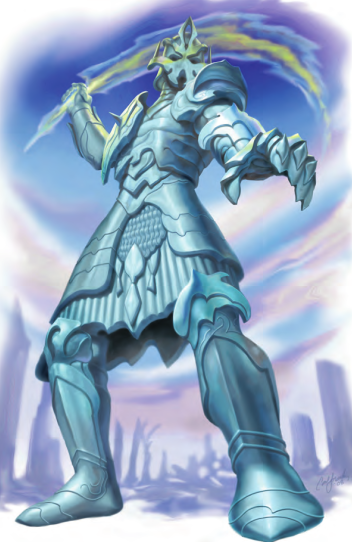Let's Read the 4e Monster Manual/Vault: Colossus

This article is part of a series! You can find all of them here.
One of the most famous D&D “monster ladders” is the one composed of golems: humanoid constructs built to do the bidding of powerful spellcasters. They’re generally inspired by mythology, with the name for the category being taken from the legend of the Golem of Prague.
Due to the vagaries of alphabetical ordering, the first “golem” our reading of the Monster Manual hits is the one standing on the very top rung of that ladder: the Colossus.
Obviously inspired by the Colossus of Rhodes, who was said to animate when its city was threatened by invasion, colossi are enormous animated statues, often made in the image of a god or another mighty entity. Like their smaller relatives, they exist to obey their creators. Of course, not just anyone can create one of these babies - it requires an epic ritual most commonly known to entities such as demon lords and divine exarchs.
The name of the single stat block given to us by the Monster Manual hammers the point home: it presents us with the Godforged Colossus. There are no colossi on the Monster Vault.
The Godforged Colossus is a Huge Immortal Animate (construct). That’s smaller than I thought it would be, but then again so was the Colossus of Rhodes. Constructs are not affected by effects that specifically target living creatures. They also don’t sleep, breathe or eat, and are immune to disease and poison.
This specific construct is a Level 29 Elite Brute with 662 HP. In addition to the standard construct immunities listed on its stat block, it’s also immune to fear and has Resist 30 to both psychic and force damage. It strides across the land at speed 10. As a golem-adjacent creature, it’s Unaligned, doesn’t speak, and has Int 4.
As its basic attack the Godforged Colossus wields a weapon made of pure force. It does an amount of force damage that’s surprisingly close to that it should be even without the math fix. A hit also triggers a relatively inaccurate secondary attack against Will, doing another bit of psychic damage and stunning the target for a turn on a hit. I feel this is a bit of unecessary complication; to fix it, add the damage of the secondary attack into that of the primary and make the whole lot “force and psychic”. I don’t think anyone who isn’t another colossus resists those two simultaneously. You could leave the secondary attack for the stun effect, or replace it with the push from the Defensive Strike (below).
The monster’s other standard actions are as follows: it can attack at a range of 20 with a Force Missile, which targets Reflex, does force damage, and pushes 5 squares on a hit. Once per encounter it can unleash the Voice of the Demiurge, which targets the Will of all enemies within a Close Burst 10 (!), doing respectable psychic damage and stunning for a turn on a hit.
Finally, as a reaction whenever someone moves adjacent to it, it can use a Defensive Strike that recharges on 5-6. On a hit it does all the damage of the basic attack (some force, some psychic) and allows a secondary attack against Fortitude that on a hit pushes the target 5 squares, knocks them prone, and dazes (save ends).
No specific mention is made of the material used to build this colossus, though judging by the resistances I’d say it’s actually made of pure force tinted with the thoughts of the god who built it.
Encounters
The book says a colossus might be a city’s greatest guardian, the idol of a god that animates to punish defilers, or a pair of great sculptures acting as guardians of another creature’s lair.
The first one is our old buddy Rhodes; the second brings to mind that demon statue from the cover of the 1e PHB; and the third is surely the sphinxes from the Neverending Story. The last boss from Shadow of the Colossus (the Tower) also fits here.
The first example encounter is level 28, a godforged colossus and 4 dragonborn champions. Tiamat or Bahamut… or maybe both, with equal teams fighting each other! Does the level 23 party dare to interfere?
The second is level 29, 1 colossus, 3 sorrowsworn reapers, and 2 shadowraven swarms. Woe be unto those who trespass upon the fane of the Raven Queen.
Final Impressions
I’m a fan of colossi, particularly of those whose shadow you can stand under. They make me wish D&D in general had more giant-climbing rules.